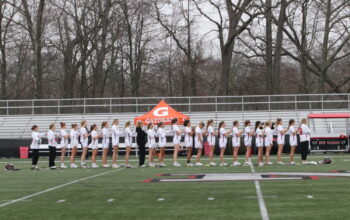Gogo Jones
Sports Editor
The last thing senior Wesley Rhudy remembers before waking up in an ambulance is the face of a running back: “I was about to make the tackle and then all of a sudden…bam, everything went black,” he said. “I woke up sometime later and my head was spinning.”
That was in middle school. And although Wesley has fully recovered, he hasn’t stepped on the football field since.
Unfortunately, Wesley’s experience is shared by over 300,000 U.S athletes every year with approximately 60,000 of those (20%) occurring at the high school level. In fact, “They happen in every sport,” said athletic trainer Diane Murphy-kivell. “Although the most recent trend we’re seeing is in girl’s soccer,” she said, crediting this to a combination of the sport’s aggressive nature and the more delicate female upper body bone structure.
Senior Sarah Mannelly, captain of the girls’ soccer team, contributed to this trend in early October when she suffered a concussion for the second time in her life. “At first I didn’t think anything of it,” she said, describing the impact, “but after similar symptoms from my first concussions appeared, I knew exactly what it was.”
Sarah, a three-sport athlete, says the experience has led her to be more cautious on the sports field. “I take it very seriously,” she said, “because ignoring the problem only leads to an even worse injury in the future.”
Concussions have not always been revered as a serious condition. Terms such as “getting your bell rung” were frequently used to convince athletes who had been hit hard that they were fine and should “man up” by continuing play. However, career threatening head injuries involving NHL players Sydney Crosby and New Canaan’s own Max Pacioretty have recently served as wake-up calls to the sports world.
Coaches and athletes alike are now fully aware that these injuries are extremely serious, sometimes fatal, and occurring more often than ever before. As a matter of fact, the Center for Disease Control and Prevention recently claimed that concussions have reached an, “epidemic level.”
Despite the unnerving increase in numbers, concussions cannot be detected by MRI’s or CAT scans, making them some of the most perplexing and consequently scary injuries. Ms. Murphy-kivell, who has been studying concussions since 2003, is more than familiar with development in neurocognitive research (brain analysis), but says all knowledge about concussions and the application of this knowledge when dealing with a patient is simply, “a tool in the process of handling a concussion.”
In addition to using everything medics already know about concussions, Ms. Murphy-kivell said each person will show different symptoms and therefore must be addressed uniquely. “Concussions are a puzzle, and we haven’t figured it out yet,” she said.
So what exactly is a concussion? Without going into too much detail, here’s the science behind it all: the normal brain is full of cells that maintain a balance of chemicals inside and out of it. When the head receives a big enough shock, chemicals from outside of the cells rush in, displacing those that are already there; this initiates a rapid chain of chemical changes within the brain, and as a cry for help, its demand for glucose (energy) increases by 150% above normal. In this state, however, your body is only able to supply it with about half of the amount needed. “It’s an energy crisis,” said Murphy-kivell. “You’re brain is being taxed of energy that it just can’t supply.”
In short, it’s a temporary disruption in brain function after sustaining a hit to the head. But in addition to the classic concussion (described above), the brain can also bang directly against the skull, as well as twist from its normal position, both of which can also cause concussions.
Most would say that the only solution for this internal crisis is a combination of time and rest. Yet despite the yearly increase in concussion research, no single diagnostic approach has been established to assess the severity of a blow. This is because treatment programs and recovery rates vary across the board, making concussions particularly hard to systemize.
Take Nick Shaw for example, a senior at King Low Heywood Thomas School, who, after suffering his second concussion in 2010 (within a year of his first), realized very quickly that something was extremely wrong. “I came back to school after that weekend and had no idea what was going on,” he said, “I had a splitting headache and it was only getting worse.”
After seeing a neurologist, Nick was selected to partake in a promising new method called “cocooning.” This technique involved sitting in a dark room and doing absolutely nothing, including thinking. That’s right, no thought. “It was extremely scary being told by a doctor not to think,” he said. “There was no guarantee that the headaches would even stop, and worrying about it only made them worse.”
After twenty-four missed school days, Nick was ready to begin easing his brain back into working full time. “I had a revised work schedule,” he said, “No tests or quizzes, just increments of work to get back into thinking again.” Eventually, Nick was able to recover fully but not without paying a price: “No more football and probably no more lacrosse,” he said.
Murphy-kivell said that any symptoms related to concussions should be recognized and reported immediately. “I can’t help you if you don’t ask,” she said, adding “a lot of these injuries go unreported.” There is extreme danger in this, she said, because it is physically impossible for your brain to regain the energy it needs if you try going through daily life with a concussion.
By resting, you can get better and more than likely be cleared to play. If indeed you are ever diagnosed with a concussion, Murphy-kivell recommends no texting, TV, computer and especially no sports…no matter how badly you want to play.
“I know it’s hard for these athletes to sit out,” she said. “But their whole world right now is high school. My job is to protect them for the future, twenty years down the road from now.”
In addition, no number has been set as a limit to how many concussions one should sustain before calling it quits on contact sports, but multiple concussions will most likely result in cognitive problems later on in life.
For more quick facts and stats on concussions, click here.





Nice article, I like the tie in to Pacioretty